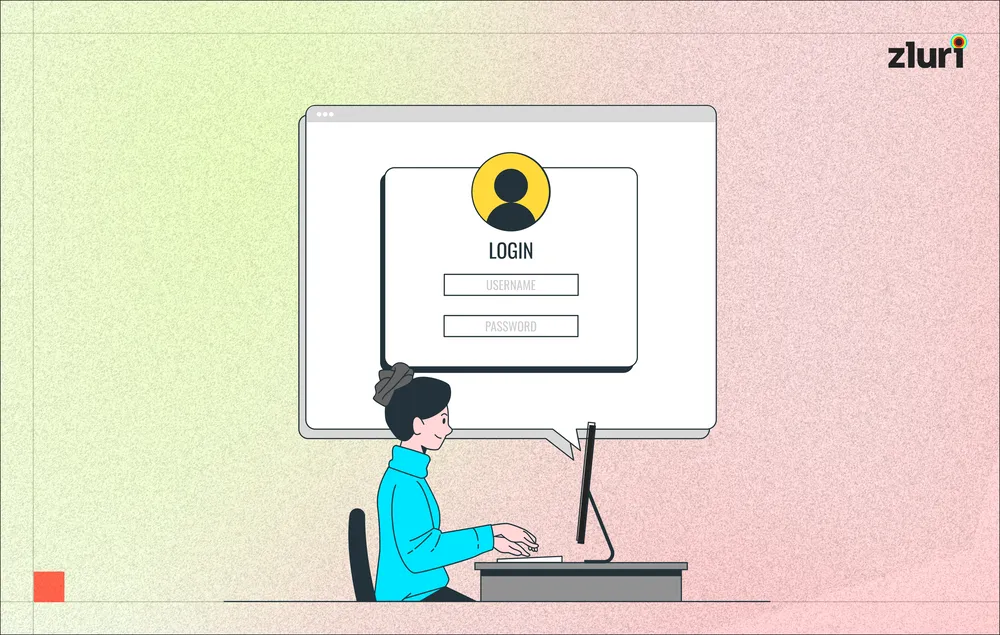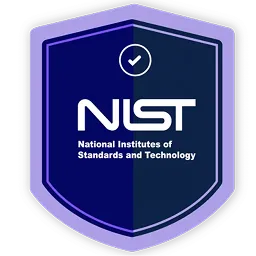To avoid falling victim to cyberattacks, it's crucial to understand them thoroughly and know how to combat them effectively. To help you with this, this article outlines 8 common challenges of cyber security and provides practical ways to address them.
With technological advancement, cybercriminals are finding innovative ways to exploit vulnerabilities and infiltrate systems to compromise sensitive data. This ongoing evolution emphasizes the need to continuously monitor potential attack vectors (routes).
However, without a thorough understanding of cybersecurity challenges, it can be extremely difficult to identify those routes and prepare strategies to mitigate these attacks.
That's why we have listed some of the most common cyberattacks that are occurring around the world. These insights will help you better understand the emerging threats and, accordingly you can create a defense system to protect your data against them.
So, let's find out what the challenges of cybersecurity are.
8 Common Cybersecurity Challenges You May Encounter
Here are 8 major challenges of cyber security that your business may encounter in today's digital landscape. We have also shared examples of cyber security threats and challenges to provide you with a better understanding.
1: Security Vulnerability In Cloud Computing Environment
Today, most organizations are choosing to store and run their data and apps in the cloud because it offers benefits like being able to access data and apps from anywhere and being more cost-effective. However, due to the increase in the adoption of cloud computing services, there's been a rise in cloud attacks. What is a cloud attack? A cloud cyber attack occurs when cybercriminals target a cloud service platform (such as IaaS, SaaS, and PaaS) that provides storage, hosting, or computing services.
But how do attackers infiltrate the system? Attackers often exploit vulnerabilities (such as access gaps) in service software to gain unauthorized access to data and disrupt business operations.
Cloud Attack Case: Microsoft Exchange Servers data breach.
In January 2021, a series of cyberattacks and data breaches started worldwide after four zero-day exploits were discovered in on-premises Microsoft Exchange Servers. These exploits gave attackers complete access to user emails and passwords, administrator privileges on servers, and access to other devices on the same network.
Also, attackers installed a backdoor, allowing them to gain continued access even after the original vulnerabilities had been fixed or updated.
By March 9, 2021, an estimated 250,000 servers were affected, impacting around 30,000 companies in the US and 7,000 servers in the UK. Various international entities like the European Banking Authority, the Norwegian Parliament, and Chile's Commission for the Financial Market were also impacted.
Microsoft released updates on March 2, 2021, to fix the exploit in Exchange Server versions 2010, 2013, 2016, and 2019. However, these updates did not undo the damage or remove any backdoors installed by attackers.
2: Ransomware Attacks Are Aiming At Critical Business Functions
Ransomware attacks emerged as a significant cyber security challenge due to their ability to disrupt business operations, cause financial losses, and compromise sensitive data. But what is ransomware?
Ransomware is a type of malicious software that can seriously harm your computer and the information it holds. It works by either locking you out of your data or encrypting your files, making them inaccessible. Additionally, ransomware can spread from one computer to another, infecting larger networks.
Those responsible for ransomware often demand payment to unlock your computer or give you back access to your files. They typically ask for payment through anonymous channels like emails or websites that require cryptocurrency.
However, paying the ransom doesn't guarantee you'll regain access, and you might lose both your money and any sensitive data on your devices.
Ransomware Attack Case: WannaCry attack on the UK's National Health Service in May 2017
The attackers targeted computers using the Microsoft Windows operating system, encrypted their data, and demanded ransom payments in Bitcoin.
This attack spread using a tool called EternalBlue, originally made by the United States National Security Agency (NSA) for Windows computers. However, a group called The Shadow Brokers stole and released this tool a month before the attack happened.
Even though Microsoft had released fixes to stop this kind of attack, many organizations didn't use them. Some said they needed their computers to work constantly, others worried that updating might break their programs, and some just didn't have the time or staff to install the fixes. But, not applying these patches left their systems vulnerable to malware attacks like WannaCry.
3: Growing Trend Of IoT (Internet of Things)Device Usage
Internet-of-Things (IoT) devices are gaining popularity due to their ability to seamlessly communicate with each other and with other systems. These devices serve as a bridge, connecting physical devices to the internet and each other without human interaction.
However, with the increased usage of IoT devices, cyberattacks targeting these interconnected systems have increased. But when does an IoT attack occur?
An IoT attack occurs when hackers or threat actors exploit vulnerabilities in Internet of Things devices. These devices usually have vulnerable security systems, making them easy cyberattack targets.
Internet of Things Attack Case: Mirai Malware 2016
This attack was recorded as one of the biggest Distributed Denial of Service (DDoS) attacks ever encountered. Mirai infected IoT devices like cameras, set-top boxes, and routers, turning them into a botnet. This botnet then targeted Dyn's DNS servers, causing major websites like Reddit, Twitter, CNN, and Netflix to go offline.
What was the gap in this case? Many devices still had their default usernames and passwords, which created a gap that allowed Mirai to easily infiltrate them and potentially target other vulnerable IoT devices.
4: Lack Of Phishing Attacks Awareness
Employees within the organization often struggle to understand whether mail or messages came from a legitimate source, making them more prone to becoming victims of phishing attacks.
Phishing is a social engineering attack cybercriminals use to steal/rob personal information like passwords and credit card numbers. They pretend to be trustworthy sources, sending emails, texts, or messages to unsuspecting people. Then, the victim is fooled into clicking on a harmful link, which can install malware on their device, freeze their computer with ransomware, or expose private information.
Example Of Phishing Attacks: Scam via email
Hackers send direct emails that appear to be from a trusted source, claiming your password needs to be changed. Furthermore, to add legitimacy, they attach a link within the email that directs you to a page where you can change your password or verify your account details.
However, if you click on the link, you could unknowingly be directed to a fraudulent website that closely resembles the legitimate one. This fake website might prompt you to fill in your credentials, including your username and password.
By doing so, you unknowingly hand over your sensitive information directly to the scammer. They can then use this data to access your accounts or commit cybercrime.
5: Unmanaged Access Privileges Within The Organizations
At times, IT teams grant excessive privileges to employees within the organizations and fail to manage them carefully. This gives way to insider attacks. This oversight creates a pathway for insider attacks to occur. What is an insider attack?
An insider attack is a type of security threat where an individual or group with authorized access to an organization's systems, data, or network intentionally or unintentionally misuses their privileges to carry out harmful actions. These actions could include stealing sensitive information, sabotaging security systems or data, or causing other forms of damage to the organization.
Insider attacks can be carried out by current or former employees, contractors, or business partners with access to internal resources. These individuals may have legitimate access to the organization's systems as part of their job responsibilities, making it easier for them to exploit vulnerabilities or bypass security measures.
There are different types of insider attacks:
- Malicious Insider: This occurs when an individual with authorized access intentionally causes harm to the company. This could be for personal profit, revenge, or other malicious motives.
- Careless Insider: In this case, the insider unknowingly causes harm due to negligence or carelessness. This could include accidentally sharing sensitive information or falling victim to phishing scams.
- Mole: A fraudulent individual who, although originally external to an organization, has managed to obtain internal access to a privileged network. This person pretends to be an employee or partner of the organization to hide their true identity.
6: Serverless App Vulnerability
Serverless apps rely on third-party cloud infrastructure or backend services like Amazon Web Services (AWS) Lambda or Google Cloud Functions. These apps make it easy for cyber attackers to target systems because users access them locally or off-server on their devices.
Furthermore, Serverless apps don't offer protection against attackers accessing our data. If an attacker gains entry to your data through leaked credentials, a compromised insider, or other means, the serverless application won't provide a defense.
Note: Common examples of serverless apps include web services and data processing tools.
7: Supply Chain Vulnerability
Supply chain vulnerabilities refer to weaknesses or cyber risks within the interconnected network of manufacturers, suppliers, distributors, and other entities involved in producing and delivering goods or services.
These vulnerabilities can occur at any stage of the supply chain process and can be exploited by hackers or bad actors to disrupt operations, compromise security, or harm the entire supply chain ecosystem.
8: Increase In Use Of Artificial Intelligence
Artificial intelligence has taken over most of the work, making it more convenient for organizations to streamline operations. Because of this, many organizations are using AI in their day-to-day operations.
For instance, AI helps security teams spot and stop security threats faster. But there's a downside, too. Bad actors can use AI to create more dangerous attacks that normal security tools might not be able to catch. And AI systems themselves can be tricked or manipulated, making them prone to AI attacks. What are AI attacks?
AI attacks occur when malicious actors misuse artificial intelligence technology to carry out harmful actions.
For example, attackers can use AI to trick users into giving away sensitive information or to make ransomware attacks more effective.
Furthermore, attackers can use AI in various ways to conduct attacks. Such as:
- They may deploy malware designed to test the effectiveness of AI defenses.
- Manipulate AI models by feeding them inaccurate data.
- Utilize AI to identify vulnerabilities in enterprise systems.
These tactics increase attackers' success rates. Also, AI-enabled techniques such as deep fakes have become increasingly convincing, making them effective tools for social engineering attacks.
While mitigating these persistent threats can be challenging, it's important to understand that they are not unachievable. So, how can we address these emerging threats? Here'Here's
How To Mitigate Cybersecurity Challenges?
Cybersecurity requires ongoing efforts and careful planning. Implementing measures such as:
- Mandatory authentication (mandating users to verify their identity through multi-factor authentication, which is two-factor authentication, every time they try to access critical data).
- Encryption (encoding data so that only authorized parties can access it).
- Monitoring for suspicious activity (like unauthorized access attempts).
- Adopting secure password practices can enhance online safety.
By staying vigilant and taking proactive steps, you can safeguard your organization's sensitive data against these emerging cyberattacks.
However, to ensure the effectiveness of your security strategies, you need to have a proper tool in place. One such tool that you can consider implementing is Zluri. What is Zluri? How is it going to help address cybersecurity challenges?
Zluri offers an access management solution that enables your team to ensure that only authorized users can access the organization's SaaS apps and sensitive data. How does it do that?
- Mandates Verification
With Zluri's access management, your team can mandate that users authenticate their identity (verify they are who they intend to be) each time they attempt to access data or SaaS apps. This will create a protective barrier between unauthorized users and the organization's critical resources (data, app, system).
- Grants Access To Only Authorized Users
Your team can seamlessly verify employees' identities by integrating with HRMS and granting them access to authorized users according to their job roles.
How does it work? This integration brings all the up-to-date data of employees into one centralized location, making it easier for your team to cross-check identities before granting access.
This helps minimize the risk of access mismanagement or the occurrence of access gaps, which cybercriminals can exploit.
- Enforces Access Control Policies
To further ensure users hold access to only what's necessary and nothing beyond, Zluri's access management enables your team to enforce access control policies like:
- Principle Of Least Privilege (PoLP)
- Role Based Access control (RBAC)
- Attribute Based Access Control (ABAC)
- Just-In-Time (JIT)
- Segregation Of Duties(SoD)
- Thoroughly Monitor Access
Zluri's access management provides a centralized dashboard that helps your team monitor who has access to what. This also helps identify if anyone holds access beyond their requirement, which can hamper data security.
With this visibility, your team can take necessary actions like restricting, modifying, or revoking user access (if necessary). This way, you can protect the data from potential security breaches.
In fact, Zluri has been named in the Gartner® Report: Reduce Your IAM Attack Surface Using Visibility, Observability, and Remediation. Download now!
Gartner, Reduce Your IAM Attack Surface Using Visibility, Observability, and Remediation, Rebecca Archambault, 8 October 2025
Gartner is a trademark of Gartner, Inc. and/or its affiliates.
Gartner does not endorse any company, vendor, product or service depicted in its publications, and does not advise technology users to select only those vendors with the highest ratings or other designation. Gartner publications consist of the opinions of Gartner’s business and technology insights organization and should not be construed as statements of fact. Gartner disclaims all warranties, expressed or implied, with respect to this publication, including any warranties of merchantability or fitness for a particular purpose.
According to KuppingerCole's research, Zluri's platform collects usage data to accurately assess SaaS app risks and alerts IT and security teams about unapproved applications, helping to reduce risks associated with sensitive company information.
You can book a demo to explore Zluri's access management solution.
Take Action Against Cybersecurity Threats In Time to Avoid Potential Pitfalls
In conclusion, cyberattacks like phishing, insider breaches, and AI-driven attacks constantly evolve, posing significant security risks to organizations' data, operations, and reputation. So, to stay ahead of these potential threats, with time, organizations must take decisive actions and implement the necessary tools to mitigate them. This way, organizations can avoid potential pitfalls and stand firm in the market in the long run.
FAQs
1: What Is Cybersecurity?
Cybersecurity is a practice that involves safeguarding networks, systems, and data from unauthorized access, alteration, or destruction. Furthermore, cybersecurity aims to mitigate risks posed by cyberattacks, such as malware, phishing, ransomware, and other forms of attacks.
2: How Do Cyber Attacks Impact Businesses?
Cyber attacks can impact businesses by causing financial losses, disrupting operations, damaging reputations, leading to legal consequences, stealing intellectual property, and incurring remediation costs.
3: What are the key factors contributing to the rise in cyber threats?
Key factors contributing to the rise in cyber threats include:
- Increasing digitization.
- Interconnected systems.
- Advanced attack techniques.
- Lack of cybersecurity skills.
- The growing value of data.







.png)

.svg)














